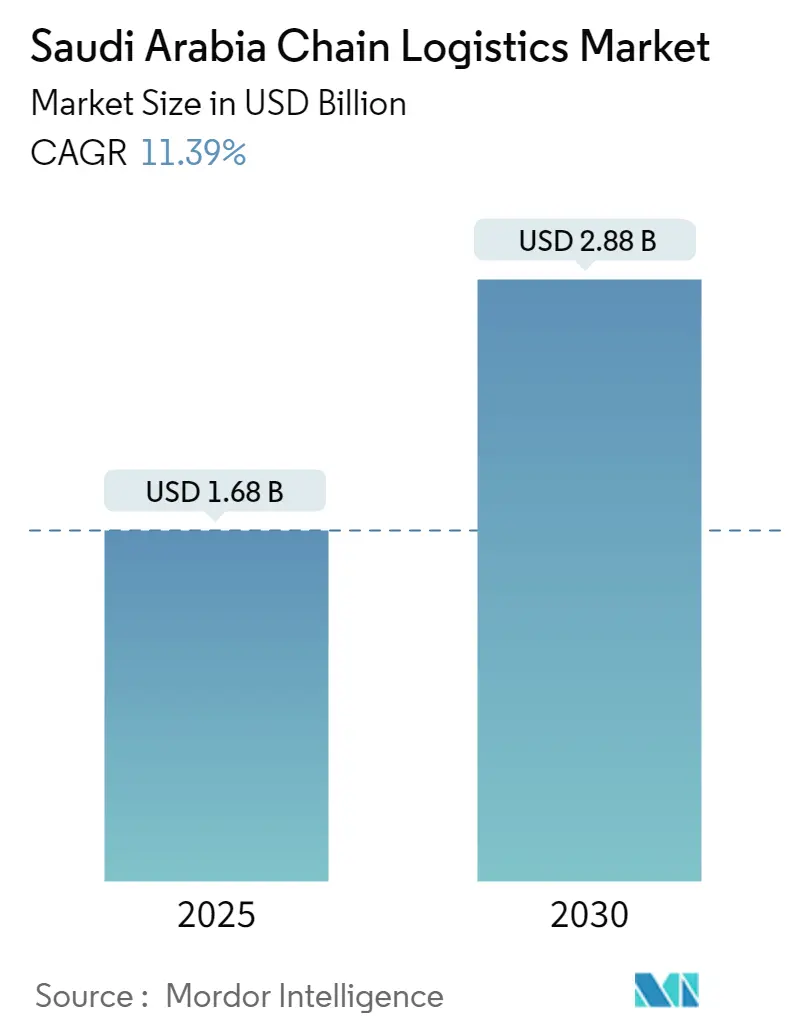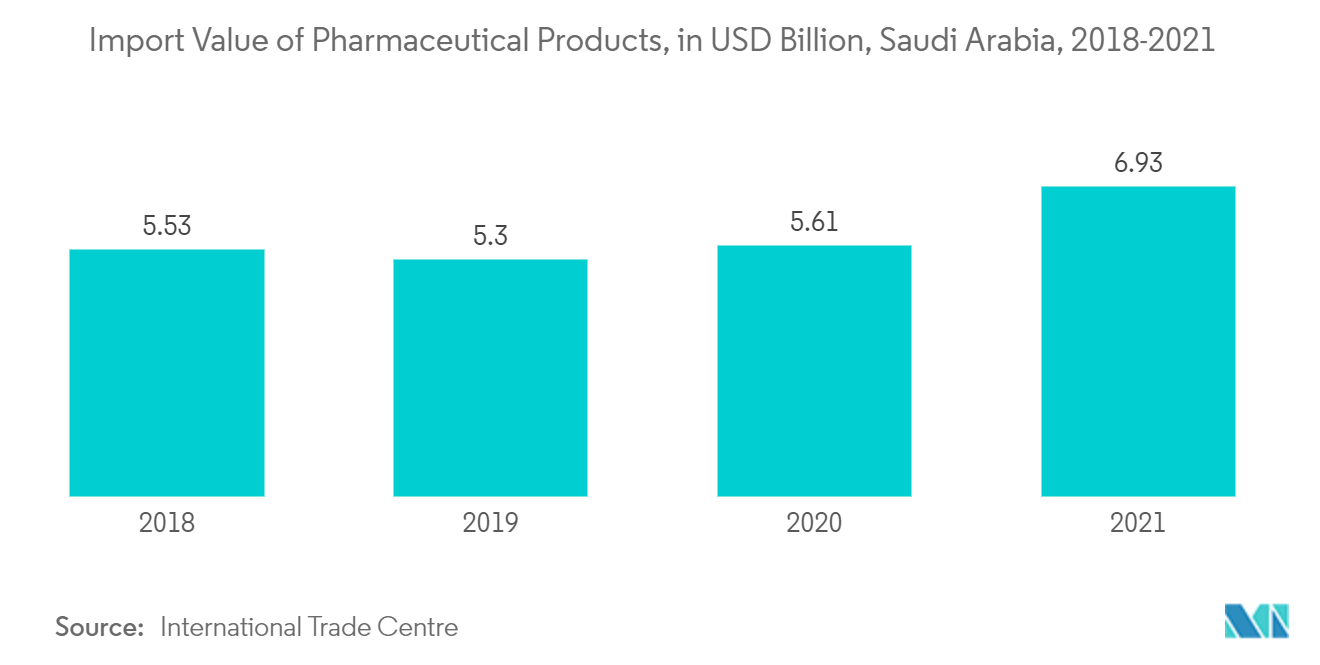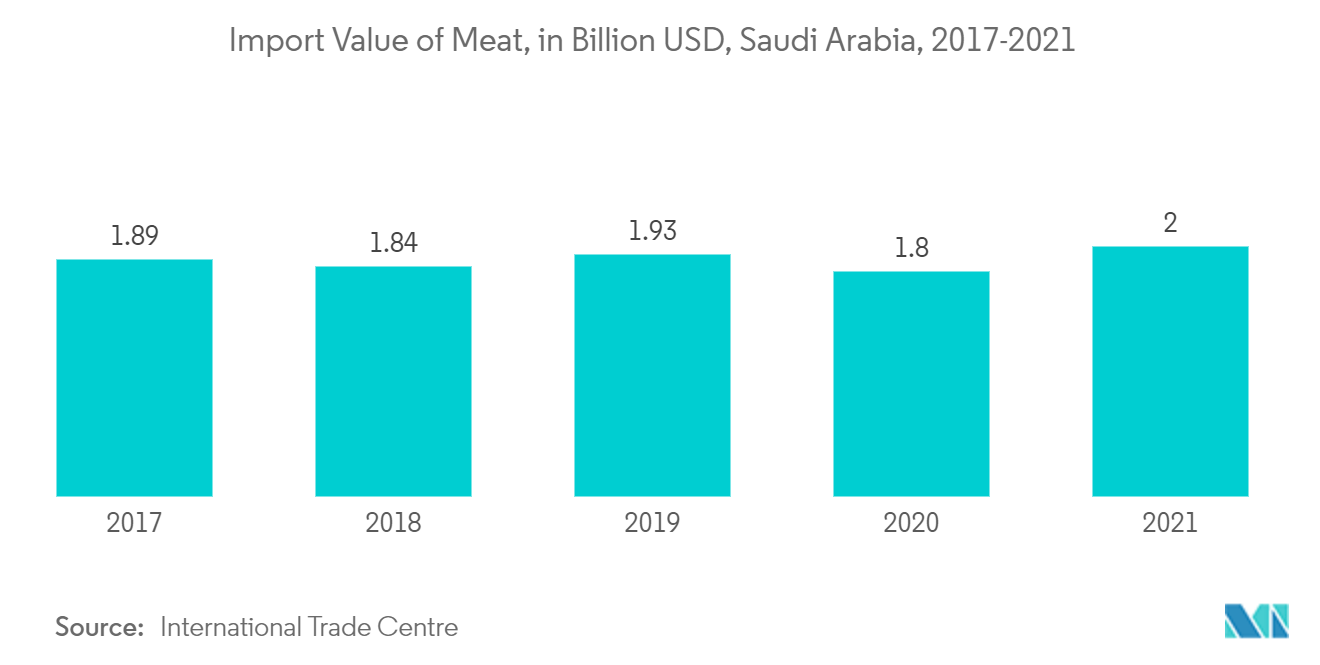Saudi Arabia Chain Logistics Market Size

| Study Period | 2020 - 2030 |
| Base Year For Estimation | 2024 |
| Forecast Data Period | 2025 - 2030 |
| Market Size (2025) | USD 1.68 Billion |
| Market Size (2030) | USD 2.88 Billion |
| CAGR (2025 - 2030) | 11.39 % |
| Market Concentration | Low |
Major Players
*Disclaimer: Major Players sorted in no particular order |
Saudi Arabia Chain Logistics Market Analysis
The Saudi Arabia Chain Logistics Market size is estimated at USD 1.68 billion in 2025, and is expected to reach USD 2.88 billion by 2030, at a CAGR of 11.39% during the forecast period (2025-2030).
- The growing urban population and changing consumer perceptions have boosted the demand for refrigerated storage and transport. The market for refrigerated/frozen products is rapidly growing in Saudi Arabia. However, implementing the cold chain in Saudi Arabia involves several challenges. One of the major challenges is the lack of integrated supply chains or limited integrated supply chains from farm to fork, coupled with the lack of standardization.
- The COVID-19 pandemic has overturned the cold chain logistics sector through massive changes in operations, supply chains, regulations, and workforce requirements. It has also transformed the market with a lasting impact on the future. The Saudi Arabian halal food market has grown due to increased demand for packaged halal foods among non-Muslims, strong import and export regulations and policies regarding halal food and products, and an increasing Muslim population in the country.
- Another key sector that requires cold chain logistics is the pharmaceutical industry, which is growing rapidly in Saudi Arabia. Different government-sponsored incentive schemes enabled several domestic players to form joint ventures and collaborations with global and regional pharma corporations, intending to grow domestic manufacture and supply to various sections of the country.
Saudi Arabia Chain Logistics Market Trends
This section covers the major market trends shaping the Saudi Arabia Chain Logistics Market according to our research experts:
Growth of Pharmaceuticals Supporting Cold Chain Logistics
The Saudi Arabian pharma market is considered one of the fastest-growing markets today, with strong export potential to serve the MENA and OIC (Organization of Islamic Countries) region with a total market of USD 120 billion. The demand for pharmaceuticals in Saudi Arabia is expected to grow substantially due to the increasing penetration of health insurance companies and the rising incidence rate of non-communicable diseases.
Furthermore, the exceptional rise in the per capita income of Saudi Arabia is also expected to foster the demand for branded pharmaceutical drugs. Another key factor driving the growth of the pharmaceutical market in Saudi Arabia is the country's strategic move to allow 100% FDI in the pharmaceutical sector.
Saudi Arabia's pharmaceutical market stood at USD 10,849.4 million in 2021. Saudi Arabia has more than 40 registered pharmaceutical factories, covering 36% of the local market's need for medicines. The Kingdom's pharmaceutical sector made an export worth USD 402.59 Million in 2021.
Rapid reforms in the healthcare sector in Saudi Arabia by the government and multinational companies are expected to propel the growth of the Saudi Arabian pharmaceutical drugs market. Currently, Saudi Arabia imports all its biological molecules, making it 100% dependent on outside products. To address this, the National Transformation Plan aims to localize 40% of the pharmaceutical sector and reduce its import dependency.

Growth of Imported Meats Demanding Cold Storage
Saudi Arabia is the largest importer of food and agricultural products among the Gulf Cooperation Council (GCC) countries, with a population more than double that of the five GCC states (the United Arab Emirates, Kuwait, Qatar, Oman, and Bahrain) together. The Saudi Arabian poultry sector has experienced major production growth over recent years.
Saudi Arabia is Brazil's second most important export market for chicken meat across the world. Notably, Brazil accounted for most poultry products in the country, capturing a share of more than 70% of the total imports, followed by France, Ukraine, and the United Arab Emirates.
The Kingdom of Saudi Arabia has a high demand for poultry meat and has been dependent on imports from other countries to satiate its demand. Thus, the country has been indulging in several trade deals with major meat-producing countries over the years. The Complete export data for major exporting countries for Jan-May 2021 shows that Saudi Arabia imported 304,564 MT of chicken meat, an increase of about 34 percent over the same period last year.
Saudi Arabia is the largest consumer of red meat among the GCC countries, with meat majorly imported from Australia, the United States, Brazil, and other countries. Saudi Arabia's per capita meat consumption is the highest in the world and amounted to nearly 50 kg. The growth in red meat consumption, production, and import of live animals for their auspicious occasion, i.e., Eid al Adha feast, utilization of Hajj meat that Islamic Development Bank manages, rise in import of red meat, and government support are some of the major factors driving cold chain logistics in Saudi Arabia as these products have a low shelf life.

Saudi Arabia Chain Logistics Industry Overview
The Saudi Arabian cold chain logistics market is fragmented. The cost of labor, land, and energy is consistently rising in Saudi Arabia. Thus, companies providing cold storage facilities to their clients are implementing automation technologies such as automated storage and retrieval systems, cloud storage, and the Internet of Things to gain a competitive advantage. Major players in the cold chain market include Agility Logistics, Mosanada Logistics, Takhzeen Logistics, Wared Logistics, United Warehouse Company, Almajdouie, and AL Jelaidan, among others. Riyadh currently has the largest number of cold storage warehouses, and the city acts as a hub through which products are transported to other regions of the country.
Saudi Arabia Chain Logistics Market Leaders
-
Coldstores Group of Saudi Arabia
-
NAQEL Express
-
Mosanada Logistics Services
-
Agility Logistics
-
Tamer Logistics
*Disclaimer: Major Players sorted in no particular order

Saudi Arabia Chain Logistics Market News
- February 2023 - A. P. Moller - Maersk and Saudi Ports Authority 'Mawani' broke ground for Saudi Arabia's largest Integrated Logistics Park at Jeddah Islamic Port. The bonded and non-bonded warehousing & distribution (W&D) facility will cover more than 70% of the total area of the Integrated Logistics Park while the remaining part will act as a hub for transhipment, air freight and LCL cargo. The W&D part will have several different sections to accommodate general warehousing and cold chain storage (fruits & vegetables, protein and confectionary & consumables). To cater to the rapid penetration of eCommerce in Saudi Arabia, the facility will also have a dedicated eCommerce fulfilment centre. The Integrated Logistics Park will be able to handle annual volumes of close to 200,000 TEUs across different products.
- November 2022 - As part of a land-concession deal announced by Saudi Arabia's State Properties General Administration, Agility, a supply chain services, infrastructure, and innovation business, would develop a huge logistics park for storage and distribution near Jeddah. Agility will invest 611 million SAR (USD 163 million) in the park and will have the right to run it for 25 years under the terms of its deal with SPGA.
Saudi Arabia Chain Logistics Market Report - Table of Contents
1. INTRODUCTION
1.1 Study Deliverables
1.2 Study Assumptions
1.3 Scope of the Study
2. RESEARCH METHODOLOGY
3. EXECUTIVE SUMMARY
4. MARKET INSIGHTS AND DYNAMICS
4.1 Market Overview
4.2 Market Drivers
4.3 Market Restraints
4.4 Government Regulations and Initiatives
4.5 Technological Trends and Automation in Cold Storage Facilities
4.6 Industry Value Chain / Supply Chain Analysis
4.7 Porters Five Force Analysis
4.7.1 Threat of New Entrants
4.7.2 Bargaining Power of Buyers/Consumers
4.7.3 Bargaining Power of Suppliers
4.7.4 Threat of Substitute Products
4.7.5 Intensity of Competitive Rivalry
4.8 Insights into Refrigerants and Packaging Materials used in Refrigerated Warehouses
4.9 Insights into Multi-temperature Controlled Vehicles
4.10 Impact of COVID-19 on the Market
5. Market Segmentation
5.1 By Service
5.1.1 Storage
5.1.2 Transportation
5.1.3 Value-added Services (Blast Freezing, Labeling, Inventory Management, etc.)
5.2 By Temperature
5.2.1 Chilled
5.2.2 Frozen
5.3 By End User
5.3.1 Horticulture (Fresh Fruits and Vegetables)
5.3.2 Dairy Products (Milk, Ice-cream, Butter, etc.)
5.3.3 Meats, Fish, and Poultry
5.3.4 Processed Food Products
5.3.5 Pharma and Life Sciences
5.3.6 Other End Users
6. Competitive Landscape
6.1 Market Concentration Overview
6.2 Company Profiles
6.2.1 Coldstores Group of Saudi Arabia
6.2.2 Mosanada Logistics Services
6.2.3 Wared Logistics
6.2.4 Agility Logistics
6.2.5 NAQEL Express
6.2.6 Al-Theyab Logistics Co.
6.2.7 IFFCO Logistics
6.2.8 Almajdouie Logistics
6.2.9 3 Camels Party Logistics
6.2.10 United Warehouse Company
6.2.11 Takhzeen Logistics*
- *List Not Exhaustive
7. MARKET OPPORTUNITIES AND FUTURE TRENDS
8. APPENDIX
8.1 Macroeconomic Indicators (GDP Distribution by Activity, Contribution of Transport and Storage Sector to Economy)
8.2 Insights on Capital Flows (Investments in the Transport and Storage Sector)
8.3 E-commerce and Consumer Spending-related Statistics
8.4 External Trade Statistics - Exports and Imports, by Product and by Country of Destination/Origin
Saudi Arabia Chain Logistics Industry Segmentation
Cold chain logistics comprises establishments primarily engaged in operating refrigerated warehousing, storage facilities, and transportation of goods in temperature-controlled vehicles. The services provided by these establishments include blast freezing, tempering, and modified atmosphere storage services. A complete background analysis of the Saudi Arabia Cold Chain Logistics Market, including the assessment of the economy and contribution of sectors in the economy, market overview, market size estimation for key segments, and emerging trends in the market segments, market dynamics, and geographical trends, and COVID-19 impact, is covered in the report.
The Saudi Arabian cold chain logistics market is segmented by Service (Storage, Transportation, and Value-added Services), by Temperature (Chilled and Frozen), and by End User (Horticulture, Dairy Products, Meats, Fish, and Poultry, Processed Food Products, Pharma and Life Sciences, and Other End Users). The report offers the market sizes and forecasts for the Saudi Arabian cold chain logistics market in value (USD Million) for all the above segments.
| By Service | |
| Storage | |
| Transportation | |
| Value-added Services (Blast Freezing, Labeling, Inventory Management, etc.) |
| By Temperature | |
| Chilled | |
| Frozen |
| By End User | |
| Horticulture (Fresh Fruits and Vegetables) | |
| Dairy Products (Milk, Ice-cream, Butter, etc.) | |
| Meats, Fish, and Poultry | |
| Processed Food Products | |
| Pharma and Life Sciences | |
| Other End Users |
Saudi Arabia Chain Logistics Market Research FAQs
How big is the Saudi Arabia Chain Logistics Market?
The Saudi Arabia Chain Logistics Market size is expected to reach USD 1.68 billion in 2025 and grow at a CAGR of 11.39% to reach USD 2.88 billion by 2030.
What is the current Saudi Arabia Chain Logistics Market size?
In 2025, the Saudi Arabia Chain Logistics Market size is expected to reach USD 1.68 billion.
Who are the key players in Saudi Arabia Chain Logistics Market?
Coldstores Group of Saudi Arabia, NAQEL Express, Mosanada Logistics Services, Agility Logistics and Tamer Logistics are the major companies operating in the Saudi Arabia Chain Logistics Market.
What years does this Saudi Arabia Chain Logistics Market cover, and what was the market size in 2024?
In 2024, the Saudi Arabia Chain Logistics Market size was estimated at USD 1.49 billion. The report covers the Saudi Arabia Chain Logistics Market historical market size for years: 2020, 2021, 2022, 2023 and 2024. The report also forecasts the Saudi Arabia Chain Logistics Market size for years: 2025, 2026, 2027, 2028, 2029 and 2030.
Saudi Arabia Cold Chain Logistics Services Industry Report
Statistics for the 2025 Saudi Arabia Chain Logistics market share, size and revenue growth rate, created by Mordor Intelligence™ Industry Reports. Saudi Arabia Chain Logistics analysis includes a market forecast outlook for 2025 to 2030 and historical overview. Get a sample of this industry analysis as a free report PDF download.



